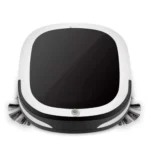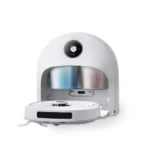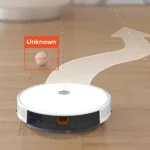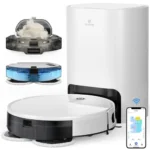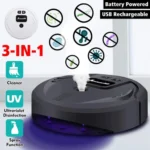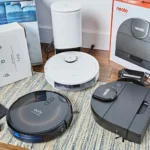Smart homes have gained popularity in recent years, with more and more people relying on technology to make their lives easier. One such device is the smart vacuum cleaner, which has revolutionized the cleaning industry. However, when it comes to navigation, there are two major techniques used – SLAM and traditional mapping. Which one is better for smart vacuum cleaners? Let’s explore both options and find out.
What are Smart Vacuum Cleaners?
Smart vacuum cleaners are the latest technological marvels of the 21st century, designed to make your life easier and your home cleaner. These innovative cleaning devices are equipped with advanced technologies such as SLAM and traditional mapping to navigate their way around your home to clean your floors efficiently. With the advent of these smart devices, consumers can now sit back and relax while their robotic assistants do all the work. In this article, we explore the two mapping technologies used in smart vacuum cleaners, SLAM and traditional mapping, and which one is better. But first, let’s take a closer look at what smart vacuum cleaners are and how they work. You can find insights about smart vacuum cleaner with SLAM technology here.
Why are SLAM and Traditional Mapping Important?
SLAM (Simultaneous Localization and Mapping) and traditional mapping are important for smart vacuum cleaners because they enable the vacuum to navigate and clean a space effectively. Without mapping technology, the smart vacuum would not have the ability to move around a room and avoid obstacles.
Traditional mapping uses sensors to detect obstacles and plan out a path for the vacuum. It relies on pre-existing maps of the room, which may not always be accurate, and can result in the vacuum missing spots or bumping into objects.
On the other hand, SLAM uses advanced algorithms and sensors such as laser range finders or depth cameras to create a real-time map of the room while cleaning. It allows the vacuum cleaner to adapt to dynamic environments by adjusting its route and avoiding obstacles in real-time, even in low light conditions.
In today’s world, smart vacuum cleaners equipped with SLAM technology are becoming increasingly popular due to their ability to navigate and clean space more efficiently compared to traditional mapping. They also have the added benefit of not requiring pre-existing maps, making them ideal for new environments, or homes with frequently changing layouts.
However, SLAM has its own set of challenges. For example, it can struggle in dark environments which could lead to missed spots or collisions. It also requires more computational power, making it more expensive compared to traditional mapping systems.
Here’s a summary of the pros and cons of traditional mapping versus SLAM technology:
| Traditional Mapping | SLAM |
|---|---|
| Relies on pre-existing maps of the room | Does not require pre-existing maps |
| Inexpensive compared to SLAM technology | More expensive that traditional mapping systems |
| May miss spots, or bump into objects | Adapts to dynamic environments and avoids obstacles in real-time |
| Works well in well-lit environments | Can struggle in dark environments |
Both traditional mapping and SLAM technology are important for smart vacuum cleaners, as they enable the vacuum to navigate and clean a space effectively. While traditional mapping is less expensive and simpler than SLAM, SLAM technology has the advantage of real-time adaptability and not requiring pre-existing maps. As technology continues to improve, it is likely that more smart vacuums will adopt SLAM as their preferred mapping system.
What is Traditional Mapping?
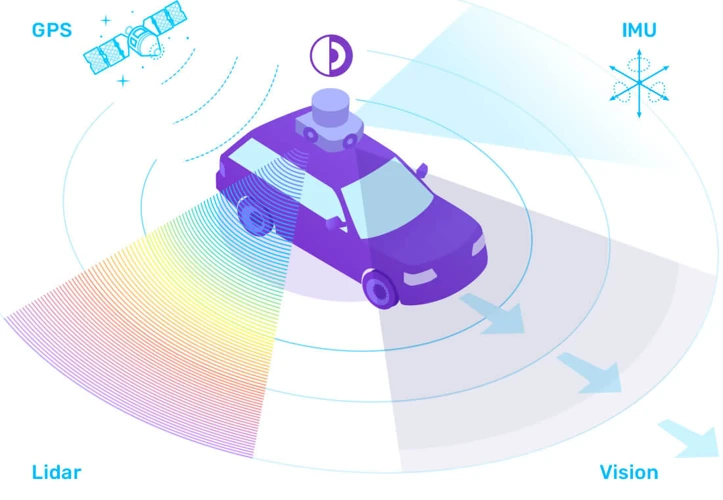
Traditional Mapping is an age-old technique that has been used for centuries to create maps and navigate the world. In the context of smart vacuum cleaners, traditional mapping refers to the process of creating a map of a space using predefined methods and sensors. The technology used in traditional mapping is different from that used in SLAM (Simultaneous Localization and Mapping) which is a relatively new approach, gaining popularity in recent years. The use of traditional mapping in the world of smart vacuum cleaners is a topic of debate and comparison, with some experts questioning its relevance in the face of newer and more sophisticated methods. To read about the benefits and drawbacks of traditional mapping, please proceed to the following section. Alternatively, consider reading about the advantages of SLAM technology in smart vacuums here.
How Does it Work?
One of the mapping technologies used in smart vacuum cleaners is traditional mapping. Traditional mapping works by using sensors to detect walls, furniture, and other obstacles in a room. Data collected by these sensors are used to create a virtual map of the room, which the smart vacuum cleaner can navigate through.
Traditional mapping works in the following way:
- The smart vacuum cleaner has sensors that detect obstacles in the room.
- The sensor data is processed to create a virtual map of the room.
- The virtual map is saved in the vacuum cleaner’s memory.
- The vacuum cleaner uses the map to navigate through the room and clean it methodically.
- Some smart vacuums have the ability to clean in straight lines, eliminating the need for repetitive passes over the same area.
One of the advantages of traditional mapping is that it is a tried and tested technology, that many users have become familiar with. Smart vacuums that use traditional mapping tend to be less expensive in comparison to SLAM technology. However, there are also certain disadvantages that come along with traditional mapping. For instance, traditional mapping does not work well in dark spaces, and can sometimes have difficulty handling obstacles that are placed in its path.
If you want to learn more about SLAM technology, check out our article on SLAM vs. Traditional Mapping: Which is Better for Smart Vacuum Cleaners? If you are having trouble with your smart vacuum’s SLAM technology, check out our Smart Vacuum SLAM Troubleshooting Tips guide.
Pros and Cons
When choosing between traditional mapping and SLAM for smart vacuum cleaners, it’s important to consider the pros and cons of each option. Here is a breakdown of the advantages and disadvantages of each:
| Traditional Mapping | SLAM |
|---|---|
| Less computationally intensive | Capable of mapping in real-time |
| Potentially more accurate | Less dependent on pre-existing maps |
| May not require as much sensor data | Can handle unexpected obstacles |
| Cannot account for changes in the environment | May be less accurate in certain lighting conditions |
| Requires pre-existing maps or a strong GPS signal | Can be more computationally intensive |
| May struggle with unexpected obstacles or changes in the environment | Potentially less accurate due to imperfect sensor data |
As the table indicates, traditional mapping may be more accurate and require less sensor data, but it cannot account for changes in the environment and may struggle with unexpected obstacles. SLAM, on the other hand, is capable of mapping in real-time and able to handle unexpected obstacles, but may be less accurate in certain lighting conditions and potentially more computationally intensive. Ultimately, the choice between the two options will depend on the specific needs and capabilities of each individual vacuum cleaner.
One real-world example of SLAM in action is the “smart vacuum cleaners slam obstacles dark” feature, which allows vacuums to navigate and clean around obstacles even in low lighting conditions. This technology utilizes SLAM to create a real-time map of the environment and avoid obstacles, allowing the vacuum to clean more thoroughly and effectively even in low light.
Both traditional mapping and SLAM have their strengths and weaknesses, and choosing the right option will require careful consideration of the specific needs and capabilities of each individual smart vacuum cleaner.
What is SLAM?
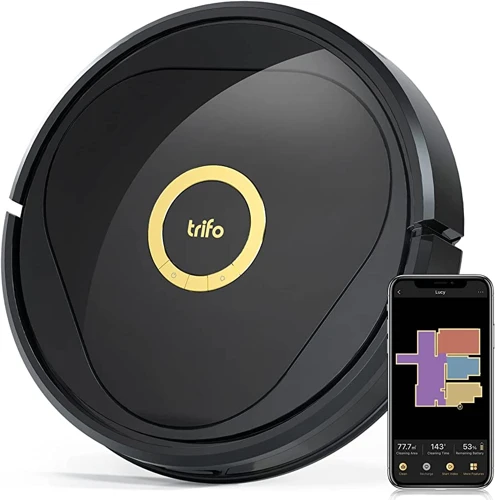
SLAM, which stands for Simultaneous Localization and Mapping, is a state-of-the-art technology used in smart vacuum cleaners to help them navigate through various obstacles while cleaning homes effectively. With SLAM, vacuums can “see” the environment they are in and create a map of it, which they can use to locate themselves and clean the area more efficiently. This is a significant improvement from traditional mapping, which relied on predetermined routes that did not account for unexpected obstacles or changes in the environment. In the next section, we will take a closer look at how SLAM works and its pros and cons. If you’re interested in how SLAM can help smart vacuums navigate in the dark and avoid obstacles, check out our previous article.
How Does it Work?
Traditional mapping involves using pre-existing maps to navigate through an environment. Here’s a breakdown of how it works:
- Step 1: A pre-existing map of the environment is created using data from satellites or other mapping technologies.
- Step 2: The smart vacuum cleaner is equipped with sensors that detect its location within the mapped environment.
- Step 3: The vacuum cleaner uses the mapped environment to plan the most efficient cleaning path.
- Step 4: As the cleaner moves through the environment, it updates its position on the map and adjusts its path as necessary based on obstacles or other changes.
As for the pros and cons of traditional mapping, here’s a breakdown:
- Pros: It’s a tried-and-true method that has been used for many years. Pre-existing maps of an environment can be highly accurate, which means less room for error when the vacuum cleaner navigates through the environment.
- Cons: Traditional mapping requires pre-existing maps, which can be costly and time-consuming to create. It also doesn’t account for changes in the environment, such as moving furniture or other obstacles.
Traditional mapping can be an effective method for smart vacuum cleaners, but it has its limitations. That’s where SLAM comes in.
Pros and Cons
When it comes to traditional mapping and SLAM for smart vacuum cleaners, both have their pros and cons. Let’s take a closer look:
| Traditional Mapping Pros | Traditional Mapping Cons |
|---|---|
| Accuracy: Traditional mapping relies on pre-drawn maps, making it more accurate when cleaning a known area. | Limited Flexibility: Traditional maps become outdated quickly and don’t account for changes in the environment, making it difficult for a robot to navigate changing scenarios. |
| Efficiency: Traditional mapping is faster and easier to process as compared with RTAB-Map (a type of SLAM) system, resulting in quicker response times from the robot vacuum cleaners. | Dependent on Environment: Traditional maps are contingent on a consistent environment, so sudden changes or obstacles can be a challenge for robot cleaners to overcome. |
| Cost-Effective: Traditional mapping requires less advanced hardware or software, making it more budget-friendly for manufacturers. | No Adaptability: Traditional mapping is unable to adapt to new environments and scenarios, limiting its use in spaces such as commercial buildings, which may have a more complex or changing floor plan. |
On the other hand, SLAM also has its advantages and disadvantages:
| SLAM Pros | SLAM Cons |
|---|---|
| Adaptability: SLAM allows the smart vacuum cleaners to adapt in real-time based on the environment, making it more efficient at navigation and cleaning. | Processing Time: SLAM requires more processing power and time, resulting in slower response times from robot vacuum cleaners. |
| Fully Autonomous: SLAM enables the robot cleaner to operate fully autonomously, without the need for pre-recorded maps or input from external sources. | Costly: SLAM requires advanced hardware and software, making it a more expensive investment for manufacturers and consumers. |
| Flexibility: SLAM has the ability to learn and adapt to new environments over time, meaning it can continue to improve and adjust its cleaning patterns. | Complexity: Manufacturers may struggle to implement and optimize SLAM technology, leading to potential malfunctions or defects in the robot vacuum cleaners. |
Ultimately, the choice between traditional mapping and SLAM depends on various factors, including the type of environment, budget, and performance needs. However, as technology advances and becomes more accessible, it’s possible that SLAM could become the go-to choice for smart vacuum cleaner manufacturers.
SLAM vs. Traditional Mapping
The battle between SLAM and Traditional Mapping has been ongoing when it comes to the world of smart vacuum cleaners. While both technologies offer their unique advantages, understanding the key differences between the two is essential so that you can make an informed decision about which is best for your particular situation. In this section, we’ll delve deeper into SLAM and Traditional Mapping, discussing how each one works, their pros and cons, and ultimately, which one is the better option.
Key Differences
When it comes to choosing between SLAM and traditional mapping for smart vacuum cleaners, it’s important to understand the key differences between the two approaches. Below is a table highlighting the differences:
| SLAM | Traditional Mapping | |
|---|---|---|
| Method | Simultaneous Localization and Mapping (SLAM) uses sensors and algorithms to map an environment in real-time while the device is in use. | Traditional mapping uses pre-existing maps or data to navigate an environment, usually through a remote control or pre-determined route. |
| Accuracy | SLAM is generally more accurate due to the use of real-time data and sensors to map the environment. | Traditional mapping can be less accurate, especially in dynamic environments where things may change between mapping and use. |
| Adaptability | SLAM is highly adaptable and can adjust to changes in the environment such as obstacles, furniture, or room layout. | Traditional mapping is generally less adaptable and may struggle with changes in the environment. |
| Cost | SLAM technology can be more expensive due to the sensors and processing power required. | Traditional mapping may be less expensive, but it may not be as effective in certain situations. |
As the table shows, there are clear differences between SLAM and traditional mapping when it comes to smart vacuum cleaners. While SLAM is generally more accurate and adaptable, it may come with a higher cost due to the need for advanced sensors and processing power. On the other hand, traditional mapping may be less expensive but may not be as effective in dynamic environments or situations where the environment may change between mapping and use. Ultimately, the choice between SLAM and traditional mapping will depend on a variety of factors including budget, environment complexity, and desired performance.
Which is Better?
When it comes to choosing between SLAM and Traditional Mapping for smart vacuum cleaners, it really depends on your specific needs and preferences. Let’s take a closer look at the pros and cons of each:
| SLAM | Traditional Mapping | |
|---|---|---|
| Pros | Accurate and detailed mapping Ability to adapt to new environments Can handle complex environments |
Faster mapping time Less expensive Requires less processing power |
| Cons | Requires more processing power Can be more expensive May not be as fast in mapping a room |
May not be as accurate or detailed Limited ability to adapt to new environments May struggle with complex environments |
As you can see, there are trade-offs with both methods. SLAM offers more accuracy and adaptability, but comes with a higher price tag and requires more processing power. Traditional Mapping, on the other hand, is faster and more cost-effective, but may not be as accurate or handle complex environments as well.
It’s important to consider your specific usage scenario and budget when making a decision between these two mapping methods for your smart vacuum cleaner. Ultimately, there’s no one-size-fits-all answer to which method is better as it depends on your unique needs and circumstances.
Real World Examples
When it comes to real-world applications, both SLAM and traditional mapping have been implemented in various smart vacuum cleaners. Let’s take a closer look at some examples below.
Dyson 360 Eye
One of the pioneers in robotic vacuum cleaners, Dyson, uses SLAM technology in their 360 Eye model. Its advanced camera system scans and maps out your home in real-time, allowing the vacuum to navigate around obstacles and clean efficiently. However, this model’s drawback is its higher price point and smaller dustbin capacity.
Eufy RoboVac 11S
On the other hand, Eufy’s RoboVac 11S uses traditional mapping sensors such as infrared and cliff sensors to detect and avoid obstacles. It also has a much lower price point compared to the Dyson model. However, its mapping process is less efficient and may require more manual intervention to ensure thorough cleaning.
Roomba i7+
The Roomba i7+ is also another example that uses SLAM technology. It is equipped with cameras and sensors that allow it to create a detailed map of your home. It also has a unique feature where it can empty its own dustbin into a larger vacuum-sized bin, making it more convenient for busy homeowners. However, it also comes with a higher price point.
Ecovacs Deebot N79S
Another smart vacuum cleaner that utilizes traditional mapping sensors is the Ecovacs Deebot N79S. It boasts infrared sensors, anti-collision sensors, and a remote control that allow it to clean efficiently and effectively. It is also much more affordable compared to other models. However, its cleaning power and durability may not be as robust.
Table comparing the real-world examples:
| Dyson 360 Eye | Eufy RoboVac 11S | Roomba i7+ | Ecovacs Deebot N79S | |
|---|---|---|---|---|
| Mapping Technology | SLAM | Traditional | SLAM | Traditional |
| Price Point | Expensive | Affordable | Expensive | Very Affordable |
| Mapping Efficiency | High | Low | High | Low |
| Cleaning Power | High | Moderate | High | Moderate |
| Durability | High | Moderate | High | Moderate |
As seen in the table above, each smart vacuum cleaner has its strengths and weaknesses depending on the mapping technology it uses. It is up to the consumer to weigh the pros and cons and decide which model best fits their home cleaning needs.
Conclusion
In conclusion, both SLAM and traditional mapping have some notable advantages and drawbacks. While traditional mapping can be less expensive and less complex to implement, it often suffers from accuracy issues and requires manual updates. On the other hand, SLAM can provide highly accurate and up-to-date maps, but it may require more advanced technology and come at a higher cost.
However, in the context of smart vacuum cleaners, SLAM is the clear winner. Thanks to its advanced technology and ability to create and update accurate maps in real-time, SLAM-enabled vacuum cleaners can navigate complex environments such as rooms with furniture and other obstacles with ease. Traditional mapping, in contrast, may struggle with such environments and require constant manual updates as the layout of a room changes.
Real-world examples have shown that smart vacuum cleaners with SLAM technology offer numerous benefits. Not only do they provide more efficient cleaning, but they can also save time and effort for homeowners. In addition, with the growing popularity of smart home devices, the demand for SLAM-enabled vacuum cleaners is likely to continue to rise in the coming years.
In summary, while traditional mapping may still have some use cases in certain industries, for smart vacuum cleaners, SLAM is the way to go. Its advanced technology and performance benefits make it the clear winner for those looking to keep their floors clean with minimal hassle.
Frequently Asked Questions
What is the difference between SLAM and traditional mapping?
Traditional mapping uses pre-existing maps, while SLAM creates a map as it navigates.
Can smart vacuum cleaners use traditional mapping?
Yes, some smart vacuum cleaners use traditional mapping technology to navigate.
What are the benefits of SLAM?
SLAM allows for real-time mapping and adaptation to changing environments.
What are the downsides of traditional mapping?
Traditional mapping relies on pre-existing maps, which can be outdated or inaccurate.
How accurate is SLAM technology?
SLAM technology can be very accurate, with some robots able to map their environment within a few centimeters of accuracy.
Do SLAM-based vacuum cleaners use cameras to map their environment?
Yes, many SLAM-based vacuum cleaners use cameras to map their environment, but they can also use other sensors such as Lidar and Sonar.
Which technology is better suited for complex environments?
SLAM technology is better suited for complex environments as it can adapt to changes in the environment in real-time.
Can traditional mapping be updated?
Traditional mapping can be updated, but it requires manual intervention which can be time-consuming.
What types of vacuum cleaners use SLAM technology?
Many high-end smart vacuum cleaners use SLAM technology.
Is one technology definitively better than the other?
It ultimately depends on the specific use case and environment. Both technologies have their strengths and weaknesses.

